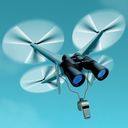Drones go out on shark patrol

Lifeguards and beachgoers are getting a new ally this summer in the fight to prevent potentially dangerous shark encounters: drones.
Why it matters: While actual shark-on-human attacks are vanishingly rare, a spate of sightings near shore has been raising alarms from Massachusetts to Hawaii recently.
- A 15-year-old surfer was injured in an apparent shark attack off Stone Harbor, New Jersey, just this past weekend.
Driving the news: New York State's parks department is getting 10 new drones to help keep an eye out for sharks this summer, Gov. Kathy Hochul recently announced, in addition to eight it's already using.
- One is a particularly advanced model, equipped with a thermal camera, laser rangefinder and floatation device.
The idea, says George Gorman Jr., regional director at the New York State Office of Parks, Recreation and Historic Preservation, is for the drones to be used to verify reported sightings.
- If a drone operator spots a shark, the waters can be cleared of swimmers until the shark leaves the area.
- The drones can also be used in other missions, including search and rescue operations, as a cheaper and quieter alternative to helicopters — or to support choppers.
- Nearly three dozen staffers have been or will be trained or hired to fly the department's drones.
What they're saying: "We'll have routine patrol during the day, but if there's a sighting, we'll get the drone up right away and have them look over the waters to see what the report is," Gorman tells Axios.
Backstory: Officials in Australia pioneered the use of drones to spot and monitor sharks near shore, in part as a more humane alternative to nets and undersea traps, per Smithsonian Magazine.
Between the lines: There's a general consensus among experts that climate change is at least partially responsible for driving sharks into new areas.
- Successful wildlife preservation efforts, another theory holds, are leading to a population bump for fish that sharks eat — and thus inviting more sharks.
- One of the "main reasons" for increased sightings on New York's Long Island, Gorman says, is that "we're seeing a huge increase in menhaden, which are bunker fish and are closer to shore. They're right off the shoreline — you can see them from the lifeguard stand."
The intrigue: Marine biologists and others are also using drones to research shark behavior, The Verge reports.
- Various shark-tracking sites, meanwhile, display individual sharks' locations in real time, powered by GPS trackers attached by researchers.
Yes, but: As sharks get easier to spot thanks to emerging technology, the number of sightings is likely to increase — yet that doesn't necessarily mean there are more sharks around than there were before.
The bottom line: The odds you'll be attacked by a shark are infinitesimal — but it's hard to argue with a low-cost way of putting beachgoers' minds at ease.
- To paraphrase Amity Island's Chief Brody: We're gonna need a bigger drone.